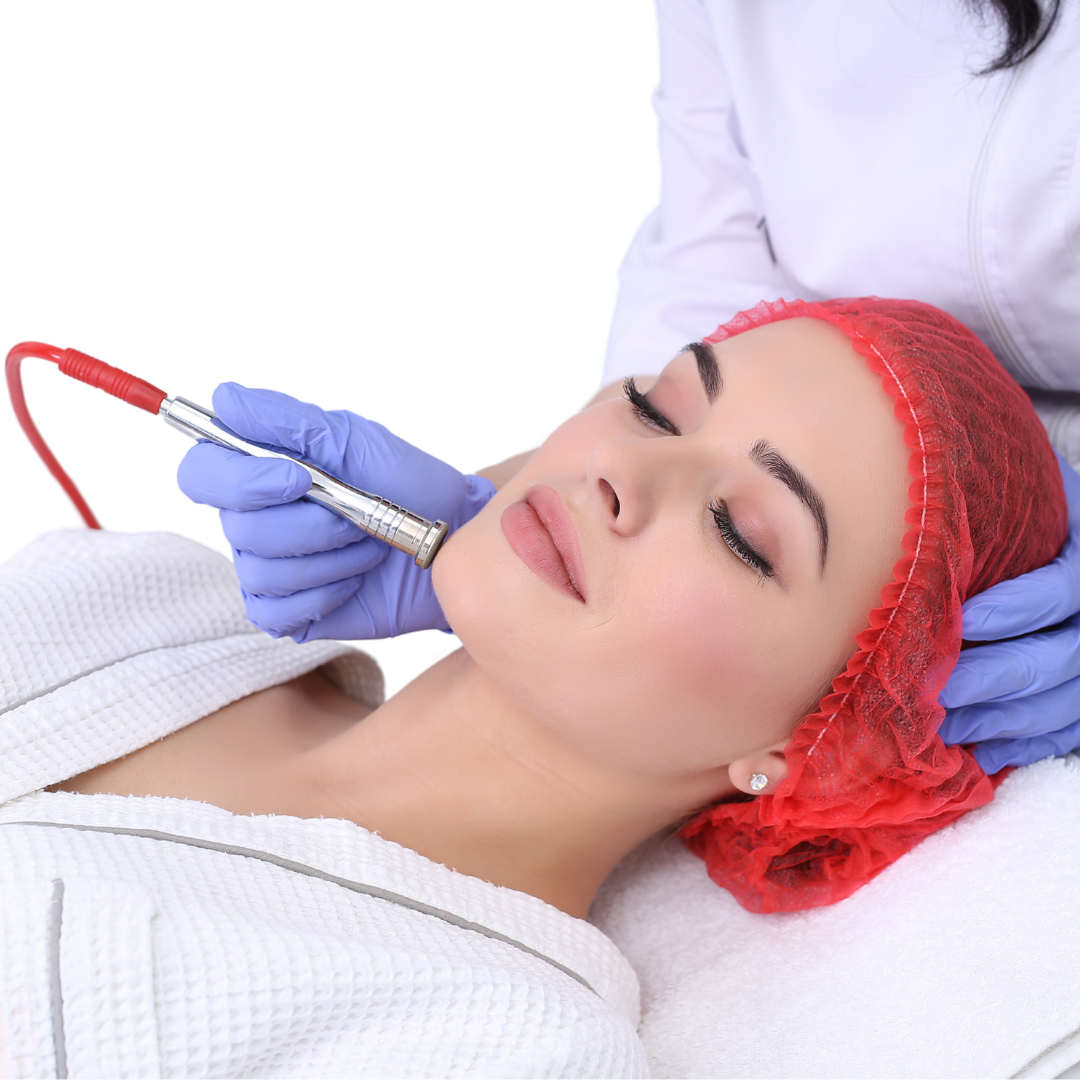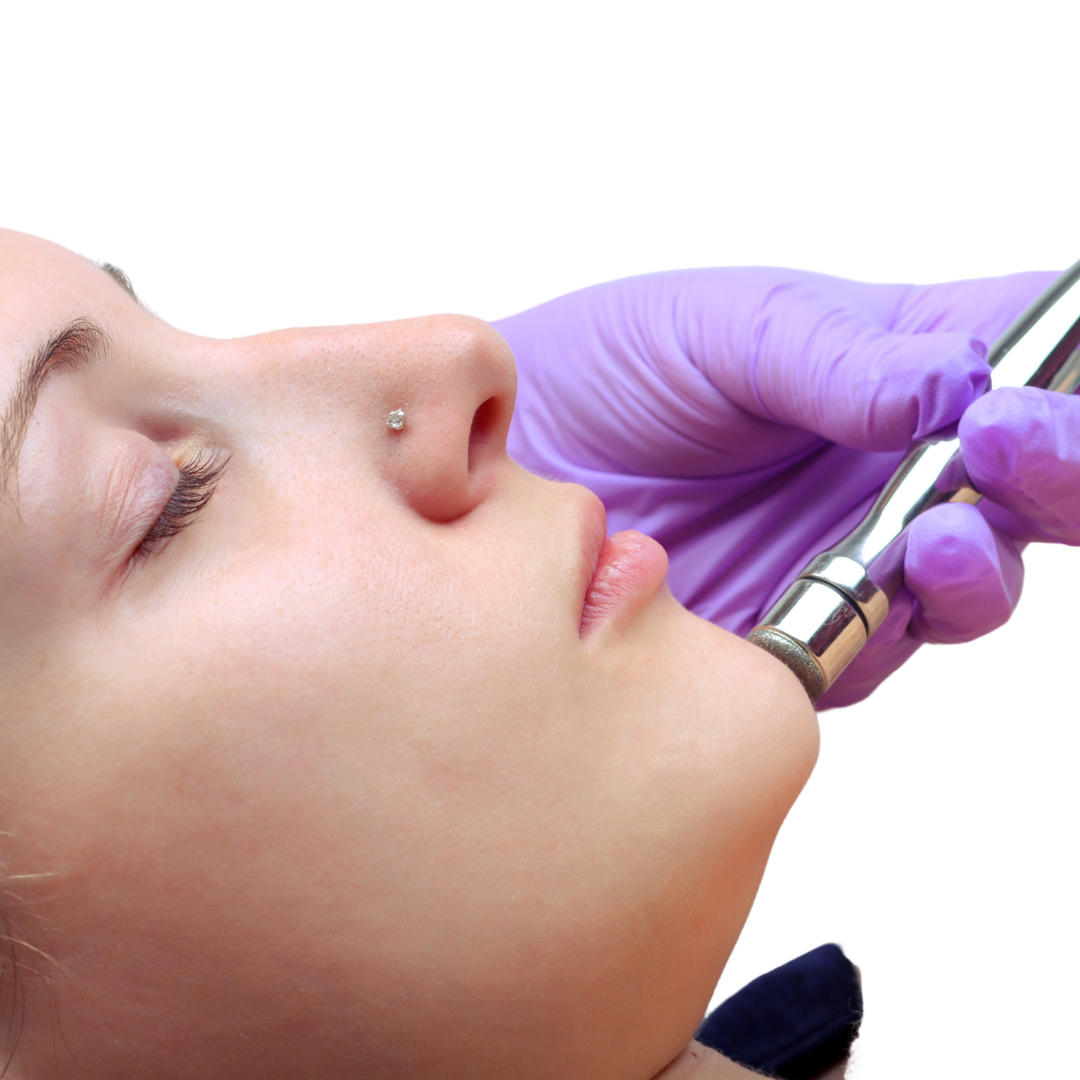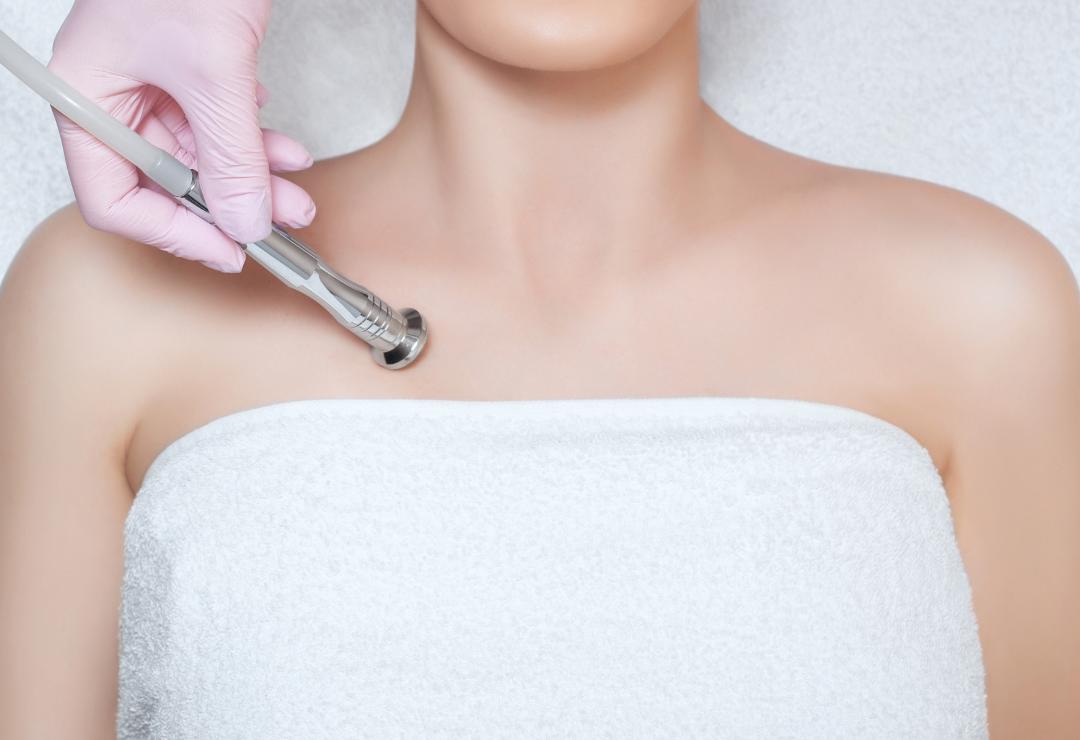Microdermabrasion
What is Microdermabrasion?
Microdermabrasion is a specialized skin treatment that involves gently scraping away the very top layer of the skin using a specialized applicator. Alternatively, a spray containing either aluminum oxide or sodium bicarbonate can be used to achieve the same effect. This treatment is generally considered safe and suitable for most skin types and colours.
Although microdermabrasion is not invasive, it requires specialized skills and tools, so it's important to have it performed by a qualified professional, here at B You Laser & Aesthetics we have qualified and experienced technicians. During the procedure, you are usually seated in a reclined position or lying down, and the technician will use the selected tools on the targeted area. Typically, the treatment concludes with the application of a soothing moisturizer and sunscreen.
There are 3 methods/devices that are chosen for the treatment:
1. Diamond-tip hand piece: This method involves a specialized tool that eliminates dead skin cells while simultaneously suctioning them away from the skin. The depth of the treatment depends on the technician’s applied pressure and the duration of application on a specific area of the skin. It is primarily used on the face, particularly around the eyes due to its precision.
2. Crystal dermabrasion: In this method, fine crystals are sprayed onto the skin to remove dead skin cells and the outer layer. Similar to the diamond-tip hand piece, there is suction integrated to immediately remove the skin and used crystals.
3. Hydra dermabrasion: This is a newer method that utilizes water and oxygen to exfoliate the skin, in contrast to the crystal-based methods mentioned above.
Microdermabrasion offers a gentle yet effective way to remove skin debris and achieve temporary improvement. You can undergo this treatment weekly or every eight weeks, depending on your skin's tolerance and desired results. Many people opt for weekly sessions for three treatments before transitioning to a monthly maintenance schedule. For continued improvement, it's recommended to undergo six to twelve sessions at intervals of two to four weeks. Just like maintaining oral hygiene, regular microdermabrasion can help you achieve the results you desire.
What are the side effects of Microdermabrasion?

1) Skin Irritation
Skin irritation is the most common side effect of microdermabrasion. It can range from mild redness and swelling to more of a burning or stinging sensation (think of a wind burn). Usually, the skin will return to normal within 24 hours. However, if the irritation is severe or persists for more than a few days, it's best to reach out to your clinician.
2) Bruising
Another side effect that can occur after microdermabrasion is bruising. This typically happens around the treated area and usually goes away within a week or two. If the bruises are excessive or don't fade within this timeframe, it's important to consult your clinician.
3)Skin Sensitivity to Light
Some individuals may experience minor sensitivity to light, as the dead skin cells are removed, thus wearing SPF is imperative to reduce this side effect. If sensitivity persists consult your clinician.
Tips To Reduce Microdermabrasion Side Effects
In general, the side effects of microdermabrasion are mild and self-resolving within a few days. However, if you encounter any severe symptoms, it's recommended to seek advice from your dermatologist. Here are some tips to help minimize these side effects:
- Avoid sun exposure before and after the treatment, apply generous amounts of SPF 30+
- Apply an ice pack to the treated area after the session
- Take ibuprofen if you experience swelling or discomfort
We hope this information has been useful! If you have any further questions about microdermabrasion or its side effects, please feel free to reach out to us.

What are the Benefits of Microdermabrasion?
Microdermabrasion can improve:
- The appearance of scars, including acne scars, fine lines, and wrinkles
- Enlarged pores
- The appearance of hyperpigmentation, or dark spots including melasma
- Uneven skin tone or dullness
- Skin elasticity by boosting collagen
- The appearance of stretch marks
- Can help declogging pores and acne breakouts
Improved Skin Texture
Microdermabrasion is a fantastic treatment for improving the skin's texture. This procedure targets coarse skin by using crystals or a hydration system to remove the outer layer of dead skin cells, which in turn reveals smooth new tissue underneath. The result is a reduction in the appearance of fine lines and a stimulation of collagen production, ultimately helping to prevent the formation of deeper wrinkles.
Minimizing Scarring and Stretch Marks
If you're on a quest to minimize the appearance of scars, whether they're from acne or surgery, microdermabrasion could be the answer you've been seeking. This treatment excels at stimulating skin tissue regeneration and breaking down scar tissue, resulting in a smoother, more even complexion. Microdermabrasion offers a promising solution to fade these stubborn stretch marks, by kickstarting collagen and elastin production, microdermabrasion works wonders on your skin's elasticity and texture. Consequently, those stretch marks gradually become less noticeable, allowing you to reclaim your smooth, flawless skin. Embrace your body's natural beauty and bid farewell to unwanted stretch marks and scarring with the help of microdermabrasion.
Enhance Skin Texture by Minimizing Pores and Acne Break Outs
Enlarged pores and acne can be a common concern for many individuals, affecting the overall smoothness and appearance of the skin. Microdermabrasion is a highly effective treatment that has been shown to minimize pore size significantly by decongesting the skin with gentle exfoliation to remove dead skin cells, excessive oils and debris. By triggering the body's natural collagen production through declogging the skin with exfoliation it helps tighten the skin, removing potential breakouts with acne, that ultimately reduce the size of pores and give the skin a more refined and flawless look.
Achieve Even Skin Pigmentation
Uneven skin tone can be an issue for many people, whether it's due to sun damage, age spots, or other pigmentation concerns. Microdermabrasion offers a solution by promoting the even distribution of melanin in the skin through in-depth treatments. This can help fade sunspots, age spots, and other forms of hyperpigmentation, resulting in a more balanced and radiant complexion over time.
Quick Recovery Time
Compared to more invasive procedures, microdermabrasion offers a quick recovery time. Following the treatment, you may experience mild redness and swelling (a wind burn sensation), which typically subsides within a few hours. This means that you can resume your daily activities without any significant interruption. Whether you have a busy work schedule or a hectic lifestyle, microdermabrasion allows you to fit in your skincare routine without having to sacrifice much of your time. With minimal downtime, you can enjoy the benefits of the treatment and continue with your regular routine seamlessly.

WHAT CAN I EXPECT BEFORE & DURING TREATMENT
Preparing for Microdermabrasion:
Leading up to your microdermabrasion session(s), it is important to discontinue the use of specific medications like ibuprofen (24 hours) and acne treatments such as Accutane. (6 to 12 months), Retin-A, Renova, Differin or glycolic acid products (72 hours prior to treatment), and avoid sunbathing and waxing (24 hours prior to treatment). If you are prone to Cold Sores around the mouth a preventative medication should be taken prior to appointment.
Microdermabrasion Procedure:
- The microdermabrasion procedure usually begins with the application of a topical cleanser to remove any oil or debris.
- Using a pen-like tool with small, sterilized diamond tip, the clinician stretches the skin and glides across the skin. The suction and sensation are minimally uncomfortable.
- The clinician ensures that the tool is moved evenly across your skin to promote even rejuvenation of the skin with multiple passes on the area.
- To conclude the session, they may apply a serum or a calming treatment with an SPF moisturizer. On average, a microdermabrasion session takes about an hour and a half.
What to Expect After Microdermabrasion:

- Microdermabrasion is a non-invasive procedure that offers a great alternative to more invasive abrasion treatments. Unlike more invasive procedures, most people experience minimal downtime, if any at all. This means that you can get back to your daily routine relatively quickly after the treatment.
- It's important to note that after microdermabrasion you may notice some skin irritation, minor swelling, and redness within the first few days your skin may feel "wind burn". This is completely normal and expected, as it is a natural response to the exfoliation treatment in your skin. However, these side effects are usually temporary and will subside on their own.
- Additionally, it's recommended to let your skin heal before applying makeup. This will allow your skin to fully recover and avoid any potential irritation. It's also crucial to protect your skin from the sun, as it becomes more sensitive after the procedure. Applying sunscreen is a must, and dermatologists usually advise to avoid sun exposure throughout treatments.
- After microdermabrasion, your skin will look glowy and radiant. You may start noticing visible results for rejuvenation properties through your personalized treatment plan over the course of a couple of weeks, such as improved skin texture and reduced fine lines. However, it's important to keep in mind that achieving optimal results may require multiple sessions or complementary treatments. Your doctor will work closely with you to develop a personalized plan based on your specific goals and needs.
Microdermabrasion vs Dermaplaning
When it comes to skincare procedures, there are various techniques that utilize different tools to achieve desired results with mechanical exfolitation/abrasion.
- Microdermabrasion, which involves the use of a handheld device along with crystals or crushed diamonds to gently exfoliate the skin. This process not only removes dead skin cells and impurities but also promotes the production of collagen and elastin, essential for skin health. The intensity of the treatment can be easily adjusted by the esthetician or dermatologist based on specific skin concerns.
- On the other hand, dermaplaning utilizes a sterile blade called a dermatome to manually exfoliate the skin and remove fine hair. The dermatome gently glides across the contours of the face, creating a smooth and refreshed complexion akin to shaving.
- These procedures provide effective ways to improve the overall health and appearance of the skin, catering to different skin types and concerns.
FAQ’S ABOUT MICRODERMABRASION

What does Microdermabrasion target?
- Microdermabrasion is commonly utilized to address issues such as skin congestion, scars, hyperpigmentation, and stretch marks, providing a non-invasive solution for improving the appearance of the skin.
How long do Microdermabrasion Results last?:
- The duration of microdermabrasion results can differ depending on factors like the seriousness of the skin condition being treated, where it is located, and the specific treatment approach.
- Typically, your clinician may suggest undergoing three to six microdermabrasion sessions to achieve optimal results with monthly follow up treatments. Following the treatment, the skin may experience heightened collagen production for a period ranging from 2 to 4 months, contributing to long-lasting improvements in skin texture and appearance.
How Many Sessions of Microdermabrasion Do I Need for Improving Minor Acne Scarring?:
- Individualized treatment plans are tailored to each person's unique needs and skin condition. Recent studies have indicated that even after 3 microdermabrasion sessions, there has been a noticeable improvement in post-acne scarring for some individuals.
- Following a series of six sessions, many individuals have reported experiencing an enhancement in their skin texture and a visible reduction in the appearance of scars.
Why is it bad to get Microdermabrasion While on Isotretinoin (Accutane)?:
- Getting microdermabrasion while on isotretinoin (Accutane) is not advisable due to the increased risk of scarring that may result from the procedure. It is important to prioritize the health and safety of your skin by avoiding potential complications that could arise from combining these treatments.
- To ensure the best possible outcome and minimize any adverse effects, it is recommended to wait a minimum of 6 months after discontinuing isotretinoin before proceeding with microdermabrasion. This waiting period allows your skin to fully recover and reduces the chances of experiencing complications during the procedure.
- By following these guidelines and allowing your skin the necessary time to heal and adjust, you can optimize the results of your microdermabrasion treatment while minimizing any potential risks associated with combining it with isotretinoin. Prioritizing the health and well-being of your skin is essential for achieving the desired outcome and maintaining its overall health and appearance.
What Are The Pros and Cons of Microdermabrasion?:
- Pros: Microdermabrasion offers a quick, more affordable exfoliation option with little to no downtime and risk, with the potential for long-lasting results.
- Cons: However, multiple sessions may be required for upkeep, and insurance typically does not cover the procedure.
What areas of the body can Microdermabrasion treat?
- Our Diamond Tip Microdermabrasion device can be used on all body parts: Face, neck, décolleté, arms, hands, legs, abdomen, and back.
Who is a candidate for Microdermabrasion treatments?
- Our device can be used on all skin types and skin colours and can address many problems, such as acne scars, stretch marks, fine lines, and wrinkles. This allows for more versatility than lasers, chemical peels, or other common ablative skin treatments, which are sensitive to darker skin types. Those that are pregnant, or have skin conditions such as rosacea, eczema, or psoriasis, are not candidates as it can exacerbate them if not being managed by doctor or dermatologist.
What is the downtime, and what side effects should I expect?
- The total healing time depends on the severity of the damaged skin, the depth of the repair process required, and how aggressively the treatment is performed. Most patients have slight swelling, heat, and redness/pinkness (like a mild sunburn) for 2-3 days. Some patients may heal completely in 24 hours.
Does Microdermabrasion smooth acne scarring?
- By inducing collagen and elastin production, microdermabrasion does aid in reducing acne scarring. After the 3rd treatment, acne scars will begin to fill in with elastin and collagen. After 6 treatments, client noticed reduction in raised scarring.
Can you use IPL Laser Rejuvenation in combination with Microdermabrasion?
- Yes. Microdermabrasion is compatible with most other non-ablative treatment modalities. IPL / LASER in combination with Microdermabrasion will further stimulate results including collagen production and evened out skin texture and tone.
Do you see a difference after one Microdermabrasion treatment?
- Yes, even the first treatment will show some enhancement with glowy skin. Fundamental differences are achieved with bi-weekly treatments to monthly. A patient will notice significant changes after the third treatment. Treatments and regiments are custom based upon a thorough consultation.
Where are you located?
B You Laser & Aesthetics is conveniently located downtown Edmonton. Our address is #155, 10403 121st NW, Edmonton. Services are currently by appointment only. We are proud to serve Edmonton & surrounding Areas
